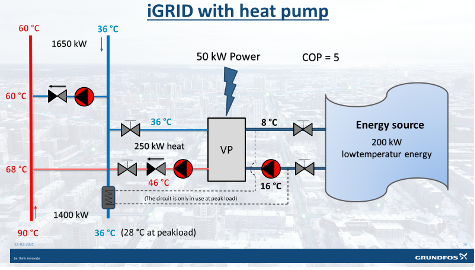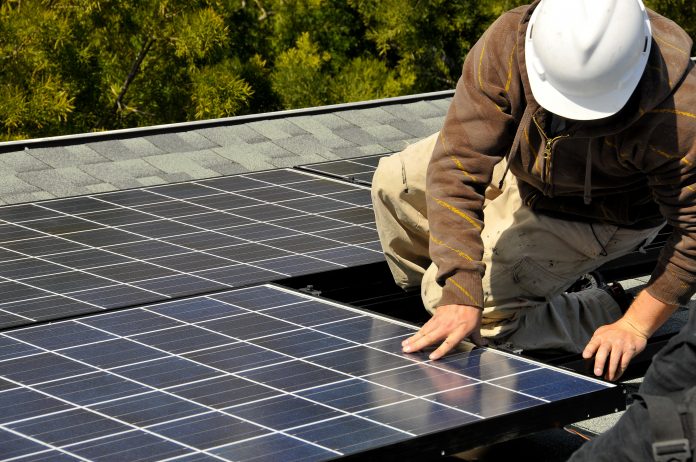Here, we learn how Grundfos Holding A/S can effectively integrate renewable energy sources in district heating by integrating heat pumps in a decentralised way
Soon, all heat energy in the district heating network must be based on non-fossil fuels, and this means that we are forced to look for all possible and available renewable energy sources and find solutions that utilise and integrate them into the existing district heating systems, without the high costs resulting from new pipes, other equipment and very expensive installations.
This approach means that district heating systems will become more complex in the future and, therefore, smart solutions must be found to integrate renewable energy and surplus heat in a cost-effective, smart and simple way, where all available sources are utilised.
We must do so because we cannot afford to exclude any of the good, reliable sources that already exist, for having cheap and non-polluting energy in the future, if we really want to change the climate situation.
It is also quite certain that in the long-term, it will become highly regarded and reputable to reuse our own energy waste as heat energy sources, instead of using unnecessary resources at a time when the world is already suffering from over-consumption of the Earth’s limited resources.
Before we reach a level of heat production based solely on non-fossil fuels, we must work in that direction by developing solutions to streamline the existing district heating systems as much as possible, to reduce climate impact and prevent resource scarcity.
What challenges do we face?
One of the major challenges is that most alternative and renewable energy sources often are available in abundant quantities when the demand is lowest, and vice versa. For example, large solar panels utilise the sunshine to produce district heating. In such plants, it might be necessary to combine the production facilities with large heat storage to balance production and consumption if the desire is to utilise the technology on a very large-scale, and it that in itself a complex and expensive task. If some utilities begin on a smaller scale, they can initially be used to cover part of the summer load, as a start. Later, when the need for more renewable energy increases, the plant can be expanded with more solar panels and heat storage.

This situation leads us away from the idea that heat energy for district heating purposes only can be produced on large central units. It will, of course, still be one of the main stations for heat production in the future, but in a version based on the utilisation of excess energy from, for example, power production based on biomass and excess energy from power to X production and other large industrial production facilities, etc.
How will we overcome this today?
Grundfos has developed a new concept named iGRID, which is designed to increase the energy efficiency in district heating grids, by dividing them into different zones with an adapted supply temperature to the exact demand in the area, depending on building types, etc. The iGRID solutions make it easier to integrate renewable energy forms as waste energy or surplus heat, in minor scale, directly into the grid locally.
One of the most innovative and extremely interesting iGRID solutions is the iGRID Temperature Zone unit in combination with a heat pump. The heat pump has the benefit, that it can pick up all kinds of low- temperature energy and transform it into a higher temperature level, to be injected and utilised for district heating as a low- temperature source to adapt the supply temperature to the required level.

The iGRID Temperature Zone in combination with a heat pump is capable of utilising locally placed energy sources such as surplus energy from a minor factory, a shopping centre or a minor server central. In some cases when there is a need for local energy production and there is no access to surplus energy, the iGRID unit with a heat pump can take energy out of the air or from wastewater in a sewer system or even drinking water.
The possibilities are limitless as long as it is possible to extract energy out of a source.
This is a new and innovative technical solution that is simple, easy to use and can utilise renewable sources in an effective way where the sources are actually present locally, even on a smaller scale.
At the same time, the decentralised set-up solution can contribute to solving local capacity problems by utilising the return pipeline as a heat source in a peak load situation. This means that the heat pump must be used in the traditional way to recover easily accessible local waste – or surplus energy for more than 95% of the annual operating time. And in less than 5% of the operating time, it can be used to remedy capacity problems in the existing district heating grid.
The iGRID Temperature solution in combination with a heat pump is simultaneously used both a technically innovative and rather uncomplicated solution and in many cases, it can prove to be extremely valuable for the utility companies as it can be used to postpone or in some cases, completely prevent large investments in new pipes to increase the capacity. This is typically extensive and expensive to implement in terms of securing the necessary heat capacity that is only available for a very limited period.
It is thus clear that the iGRID solution with a heat pump, typically with lower costs, in many situations can provide the necessary capacity increase in peak load situations by simply utilising the energy in the return line more efficiently. This means that the IGRID temperature zone solution in combination with a heat pump offers great potential for getting started with the transition from fossil energy to renewable energy in small steps, while at the same time streamlining the existing district heating system significantly at low cost.
Further information can be obtained from Grundfos:
GRUNDFOS Holding A/S
Poul Due Jensens Vej 7
DK-8850 Bjerringbro
Denmark
www.grundfos.com
*Please note: This is a commercial profile











